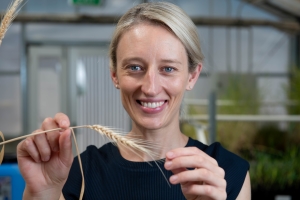Synchrotron technology sheds light on root distribution
Synchrotron technology sheds light on root distribution
Date: 04 Jan 2022

Access to the best scientific infrastructure Australia has to offer has boosted the work of three young gun researchers aiming to improve the country’s crop management practices and profitability.
The Grains Research and Development Corporation (GRDC), in partnership with the University of South Australia and the University of Queensland, is supporting a unique collaboration project between scientists, Dr Casey Doolette, Dr Helen Hou and Dr Han Weng to better understand factors that limit root growth within soil.
The trio has been given access to The Australian Synchrotron, one of the country’s most significant pieces of scientific infrastructure. Located in Melbourne the synchrotron produces powerful beams of light that are a million times brighter than the sun and allow researchers to examine the molecular and atomic details of a wide range of materials.
These electron beams travel just under the speed of light - about 299,792 kilometres a second. The intense light they produce is filtered and adjusted to travel into an experimental workstation, where light reveals the innermost, sub-macroscopic secrets of a multitude of materials, including plants.
From a research perspective synchrotron light offers several advantages over conventional techniques in terms of accuracy, quality, robustness and the level of detail that can be seen and collected. The process is also much faster than traditional methods.
These young researchers have been using the facility’s imaging and medical beamline (IMBL) to produce high quality, 3D imagery of roots growing directly into large, undisturbed soil cores.
Dr Helen Hou from the University of South Australia said the high quality of the IMBL imagery had been invaluable, providing extremely high-intensity X-rays that allowed the team to examine how the roots were growing in the soil.
“This technology has provided more realistic and informative analysis,” she said.
“Understanding soil factors that limit root growth is a critical aspect of improving crop yield and profitability across the Australian farming industry.”
GRDC Acting Senior Manager Agronomy, Soils, Nutrition and Farming Systems, Kaara Klepper said understanding root distribution was the key to improving cropping yields, especially in constrained soils, as it influences a plant’s water regulation and nutrient uptake.
“Roots have often been referred to as the ‘hidden half’ of cropping because they’re concealed in the soil,” she said.
“That’s why having access to technology like the IMBL is so important – these scientists are developing methodology which can be used to understand root dynamics.”
“It allows researchers to thoroughly examine undisturbed root distribution, giving them insight into the interaction between soil, organic matter and root growth.”
Dr Klepper said partnerships that support a cohort of next generation researchers is important to advancing the grains industry.
“The GRDC continues to nurture early career researchers and facilitate access to the scientific infrastructure needed to do world leading work,” she said.
“The GRDC is committed to investing in building the capacity and ability of grains researchers so their work can contribute to the enduring profitability of Australian grain growers.”
To read more about these projects, or the industry’s next generation scientists go to GRDC’s GroundCover online
Contact details
For interviews
Casey Doolette,
08 8302 6233,
casey.doolette@unisa.edu.au
Peter Kopittke
07 3346 9149
p.kopittke@uq.edu.au
Enzo Lombi
0401 704 195
Enzo.lombi@unisa.edu.au
Contact
Toni Somes, GRDC
0436 622 645
Toni.somes@grdc.com.au
GRDC Project Code: USA1910-001RTX , UOQ1910-002RMX, UOQ1910-003RTX,
